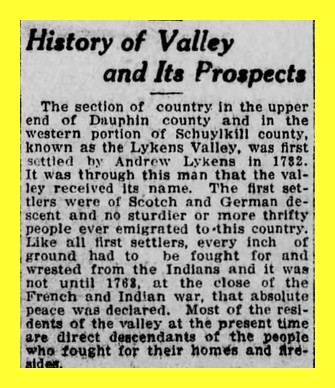The Midland Pennsylvania Railroad, begun in 1910, with plans to connect Millersburg, Dauphin County, Pennsylvania, with Ashland, Schuylkill County, Pennsylvania, turned out to be a colossal failure. In addition to the two terminal points of the railroad, stations were planned in Killinger, Berrysburg, Gratz, Springville, Valley View, Weishample and Mable. Great plans were formulated for the growth of commerce and farming. Much of the hype was presented in a Harrisburg Telegraph article in 1911. That article is transcribed here in several parts, with part five presented today.
In this part of the story, the history of the Lykens Valley and its prospects as related to the coming of the railroad was given.
From the article that appeared in the Harrisburg Telegraph, 16 March 1911:
History of Valley and Its Prospects
by Robert F. Gorman
The section of the country in the Upper End of Dauphin County and in the western portion of Schuylkill County, known as the Lykens Valley, was first settled by Andrew Lykens [Lykans] in 1732. It was through this man that the valley received its name. The first settlers were of Scotch and German descent and no sturdier or more thrifty people ever emigrated to this country. Like all first settlers, every inch of ground had to be fought for and wrested from the Indians and it was not until 1763, at the close of the French and Indian War, that absolute peace was declared. Most of the residents of the valley at the present time are direct descendants of the people who fought for their home and firesides.
Considering the fact that there have never been any railroads in the country, it is remarkable to note the progress made. At the present time there are, on an average, forty farms to a mile. The farmers are thrifty and progressive and manage to keep their farms in good condition at all times. However, there are a few, as in every community, who allow their lands to go to waste. The house and barns in most parts of the valley are in splendid condition. The recent organization of the Board of Trade for the valley and the subsequent organization of a board in every town, shows that the people are active and endeavoring to push ahead.
In the valley there are twelve towns, the populations of which vary from 100 to 7,000, Ashland being the largest. In all of these within the next few years will be established sanitary sewage systems, water works and lighting plants. Plans for these improvements are now being discussed in the various councils and Boards of Trade.
The soil in all parts of the valley is fertile and it has been said that “Lykens Valley does not possess a foot of land that cannot be profitably cultivated.” The Lykens Valley Development Company has a plan whereby it will test all farms, It is the intention of the company to secure large farms, and after testing them for a year, to dispose of them in ten acre tracts. During the test it will be learned what can most profitably be grown on the tract and the purchaser will be given the benefits of these tests. It is a well=known fact among farmers that small acreage, properly cultivated, brings larger returns at less expense than a large acreage improperly cultivated. The small farm idea appeals to the farmers of the Lykens Valley and within a year it will prevail. In various parts of the valley, wheat, corn, oats, rye, hay, various kinds of fine fruit, vegetables, and live stock can be raised at a good profit.
Of course all of these articles have been grown in the valley for years, but they have never had much chance to get to the outside world. The railroad will remedy this.
The next part of this series will be entitled “Abundance of Coal in Valley, 1911.”
_________________________________
News article is from Newspapers.com.
Corrections and additional information should be added as comments to this post.
